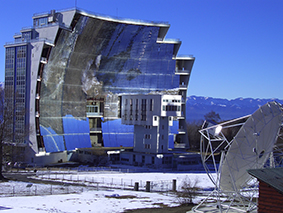Investigation of heat transfers with particle-resolved simulations: From Stokes flow to fluidized bed
Résumé
Particle-Resolved Simulations (PRS) of fluid–solid particles are conducted to study fluid–particle heat transfers and wall-to-bed heat transfers in an anisothermal liquid–solid fluidized bed. An overview of existing PRS methods to study anisothermal fluid–solid flows is presented. In the framework of fluidized bed simulations, the collision detection method is optimized using Verlet tables. The overall computation time is reduced by 20%. An original Lagrangian method to compute the fluid–particle heat transfers is presented for an isolate particle. A parametric study on the fluid–particle heat transfer is performed to assess well-known correlations of the literature for a settling particle in a quiescent fluid. 77 PRS are performed for Reynolds numbers between 1 and 32 and Prandtl number between 0.1 and 10 for a grid resolution of 20 meshes per particle diameter. For two of three correlations considered, the predicted heat flow is within 10% error. An anisothermal fluidized bed of 2134
particles is finally studied. Four fluidization velocities are considered for a solid fraction comprised between 0.13 and 0.35. Three grid resolutions are carried out to assess the sensitivity of the mesh for the lowest fluidization velocity (12, 24 and 36 meshes per particle diameter). Results show that the macroscopic behavior of the bed is well retrieved even with a coarser grid as the solid fraction is well predicted. However, strong effects of the grid resolution are observed on the fluid–particle and the wall-to-bed heat transfers. The study of the velocity–temperature correlation shows that the parietal heat transfer is driven by the turbulent heat flow near the wall (x ~ 30)
).
| Origine | Publication financée par une institution |
|---|---|
| licence |





